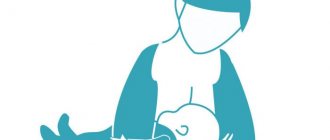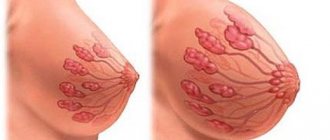Women who have had or are about to have a caesarean section often worry whether the consequences of the surgical intervention will affect the organization of their breastfeeding, the quantity, quality and speed of milk retention.
There is no need to worry about this, as experts say that the operation does not significantly affect the appearance of milk. In this case, the duration of breastfeeding will be the same as for women who gave birth in the usual way.
But still, some features of the beginning of breastfeeding in women in labor after cesarean section are present.
Appearance of milk
After a cesarean section, a delay in the appearance of breast milk is normal. This happens due to drug intervention during childbirth. It also happens that after surgery, a child is put to the breast a little later than children after a natural birth.
What affects the timing of appearance and when lactation begins after surgery:
- A woman’s milk appears within the first seven days after surgery;
- the drug therapy used is temporarily affected;
- An important factor is the time at which the baby is put to the breast;
- duration of breastfeeding.
Women who are with their baby start breastfeeding faster. If the mother has recovered or is still feeling the consequences of the operation, but is in a more or less normal conscious state, then it is already worth putting the baby to the breast.
Communication with a newborn helps restore the psycho-emotional background, normalizes the functioning of the central nervous system and brings many positive emotions. This will help the mother recover faster and begin breastfeeding her newborn.
What could be the consequences?
Taking antibiotics in most cases is accompanied by side effects. Especially if you neglect your doctor’s advice, exceeding the dosage or taking it longer than prescribed.
The occurrence of complications associated with taking antimicrobial drugs depends on the condition of the woman’s body, as well as on the pharmacodynamics and pharmacokinetics of the drug. Different groups of antibiotics have different side effects.
The most common consequences after using antibacterial treatment:
- digestive disorders (diarrhea, constipation);
- disturbance of the vaginal microflora, the appearance of thrush;
- allergic reactions (from small rashes to anaphylactic shock);
- decreased immunity;
- renal or liver failure;
- disturbance of nervous activity.
But if the dosage is strictly observed, then the negative consequences are minimized. Diarrhea (diarrhea) after antibiotics during cesarean section is not as common as constipation. Thrush also often appears when taking antimicrobial drugs.
In order to reduce the likelihood of digestive disorders and vaginal microflora, certain medications are prescribed. For example, Bifidumbacterin, Fluconazole, Pimafucin and others.
Attention! Before taking any medications, consult your doctor!
Pain and help
After any operation, pain and heaviness are felt for some period. A caesarean section can cause a deterioration in milk flow during feeding or when expressing.
What influences this?
- The stress suffered can cause blockage of milk production, oxytocin will be poorly produced;
- Pain during surgery. These may be unpleasant sensations that anesthesia did not help to cope with;
- Performing an emergency caesarean section. The decision on this is made immediately at the time of birth when special indications are identified.
If something similar was observed, the woman may need outside help. A nurse or midwife can come to help. They will teach you how to do a light massage before feeding.
How to prepare for the feeding process?
- gently massage your breasts;
- an assistant can do a simple massage of the back and shoulder girdle;
- It is recommended to drink a warm drink before feeding
- take the most comfortable relaxed position.
All this helps increase the milk supply, and the baby will receive adequate breastfeeding.
If a woman experiences quite severe pain, she should consult a doctor. You can take any medications yourself only as prescribed by a doctor.
The peculiarity of women giving birth after a cesarean section is that often at first the woman needs the presence of an assistant.
He must help the woman, pick up and bring the baby for feeding. During breastfeeding, maintain or change the position of the baby. When a woman is at home, these functions are performed by someone close to her.
Such measures are necessary until the mother recovers from the operation and begins to independently care for the baby. But many mothers manage their baby almost immediately after the operation, overcoming the difficulties of their situation. If you are in pain, uncomfortable, or difficult, do not hesitate to ask for help.
What do the doctor's say
Doctors say that prescribing antibiotics before and after surgery is necessary to exclude infectious complications. It is important to correctly draw up a treatment regimen, as well as supplement it with drugs that reduce the harmful effects of drugs on the intestinal microflora. It is also necessary to prescribe medications to prevent the development of thrush.
Antibiotics are injected for 1 to 7 days, depending on the following factors:
- whether a caesarean section was scheduled or is it an emergency operation;
- how severe the blood loss was;
- whether there were signs of infection;
- on the condition of the mother and child after surgery.
If the operation was completed without complications, the woman’s condition is satisfactory and there are no signs of infection, then a short course of antibiotic therapy is prescribed. In this case, a long-acting antibiotic is administered once.
It is important to choose the right duration of drug therapy. If you choose the wrong course, the risk of developing infections and complications increases.
In most cases, after abdominal delivery, antibiotic drugs approved for lactation are prescribed. But before breastfeeding, it is better to consult a doctor.
If the doctor’s recommendations are not followed or drug therapy is refused, the risk of complications for both mother and child increases!
Features of a newborn
Infants who were born via cesarean section have some peculiarities. They do not affect the development and growth of the baby in any way. But they have an impact on the process of starting feeding.
How do babies behave after a caesarean section?
- Children born during the operation are a little lethargic at first and sleep quite a lot. This occurs due to the effects of medications that were used during the caesarean section;
- After a caesarean section, the process of active breastfeeding begins later. But there is nothing unnatural about this;
- Newborns may not respond to breastfeeding at first. To get through this stage you will need to put in a little effort and patience.
These difficulties can be overcome and subsequently the child will grow up healthy and receive adequate nutrition from mother’s milk.
When are antibiotics needed?
There are no strict and generally accepted recommendations for prescribing antibacterial therapy. Each medical institution has local principles and combinations of drug groups that are most popular and effective in their opinion.
It is known that in the first 4 - 6 hours after any intervention during childbirth, a woman’s body is most vulnerable to all kinds of infectious pathogens. And if you determine the concentration of various microbes in the wound, it will be maximum at this time. Whether the body can cope with this condition on its own is unknown and impossible to predict. Based on this knowledge, many doctors build the principles of antibiotic prophylaxis after cesarean section.
Thus, if the operation is performed as planned, and the woman is not at risk for the development of purulent-septic complications, and the intervention itself took place without any complications, antibiotics may not be prescribed or the minimum and shortest dose may be determined. Usually the latter is preferred.
In the following cases, the prescription of antibacterial drugs is mandatory:
- When a caesarean section is performed as an emergency, or if the woman has already spent some time in labor.
- With premature rupture of amniotic fluid, even if it did not have a special odor and was transparent.
- If signs of infection are detected during childbirth. These include green amniotic fluid with an unpleasant odor and symptoms of inflammation in the vagina.
- If at the time of the operation the woman is in an immunodeficient state. For example, if you suspect an acute respiratory viral infection, with an increase in body temperature, with an exacerbation of pyelonephritis, with signs of herpes, etc.
- In the case of premature birth, since in 60% of cases they occur due to a hidden infection.
- If a woman is at risk for septic complications (suffered some infections during pregnancy, has anemia, chronic immunodeficiency conditions, had some kind of surgical intervention during pregnancy, etc.). In this case, the risk of developing purulent complications is very high, so antibiotic prophylaxis is always carried out.
- In case of massive blood loss during cesarean section, during transfusion of blood products.
How to establish contact between a child and mother?
- The baby can simply sleep on the chest. This promotes the development of natural reflexes; many newborns are initially unable to latch on to the breast;
- In order to teach him to do this, you need to have patience. Babies will still start breastfeeding if mom makes an effort. Natural feeding consultants or female acquaintances who have had positive experiences with breastfeeding can come to help;
- There is no need to feed on a strict schedule. But at first, try to offer your baby the breast at least once every hour and a half in the first days and once every two hours thereafter during the first weeks or months;
- You can provoke the baby's searching-sucking reflex by squeezing milk or colostrum so that it gets on the baby's lips, and also by moving the nipple along the nasolabial triangle.
Until the baby learns to suckle well, you need to help him during feeding, using the breast compression technique that the consultant will show.
If the baby cannot latch onto the breast at all, then the mother must express milk and feed the baby from a syringe without a needle or with a spoon, most importantly not from a bottle, since a nipple on a bottle may further jeopardize future breastfeeding.
results
- Among 6,584 women, 6,163 (93.6%), 274 (4.2%), and 147 (2.2%) received cefazolin, a standard alternative, or an inappropriate alternative, respectively.
- Use of the standard alternative antibiotic, compared with cefazoin, was not associated with an increased risk of the primary endpoint (adjusted odds ratio, 1.63 [95% CI, 0.97–2.60]) but was associated with an increased risk of cellulitis (1.93 [95% CI, 1.03–3.31]).
- Use of unapproved antibiotics, compared with cefazolin, was associated with an increased incidence of the primary endpoint (adjusted odds ratio, 4.13 [95% CI, 2.59–6.36]), as well as all components of the composite endometritis endometritis. (6.68 [95% CI, 3.69–11.44]), cellulite, 3.23 [95% CI, 1.63–5.81]).
Experience of the last century
Breastfeeding after caesarean section has been strongly recommended since around 1980. Previously, such mothers were immediately advised to use formula milk and not try to breastfeed their newborn.
A small percentage of women giving birth did not refuse breastfeeding. This approach of specialists was due to the development of the production of a large number of new infant formulas that can replace breast milk.
Previously, caesarean sections were always performed under general anesthesia, which was considered incompatible with breastfeeding. It was also believed that artificial nutrition could completely replace breast milk. Doctors even believed that such women would not produce milk.
The mechanism of milk production after natural birth and after cesarean
Throughout pregnancy, a woman’s body prepares for a very important postpartum process - feeding. A long time ago, women developed a stereotype that cesarean section and breastfeeding are incompatible. The point is a special hormone oxytocin, which begins to be actively produced with the appearance of the first contractions. It signals that the baby is about to appear and the body produces milk.

A cesarean section is usually a planned operation, doctors do not wait for contractions, and the hormone is not produced. Therefore, many people think that they should not expect milk after a cesarean section. But this is a deep misconception. Firstly, oxytocin works in tandem with prolactin, a hormone necessary for lactation. If the endocrine system is normal, then there is no need to worry about its absence. It is also important how the operation went - planned or emergency.
A healthy mother will produce milk, just with a slight delay. And during this period, the most important thing is to put the baby to the breast as often as possible. It is no longer a great secret to anyone that the amount of milk depends on how often the mother breastfeeds the baby. Therefore, in order for lactation to quickly normalize, it is necessary to do the first latch in the delivery room, immediately after the baby is born.
Breastfeeding after CS today
Currently, attitudes towards breastfeeding after cesarean section have been completely revised. The onset of lactation begins regardless of the method of birth. The difference lies in the behavior of the baby and the mother in labor.
In case of surgery, the mother will need outside help. If the child was not born naturally, the woman in labor needs to be with the baby as much as possible so that a connection between them is quickly established.
Features of a woman’s condition after a caesarean section:
- After surgery and the use of general anesthesia, a woman may experience drowsiness and slight lethargy. This condition will go away after the drugs have completely worn off. The baby's behavior cannot be predicted. Some children begin to try to breastfeed after the first attachment while still in the delivery room. Shallow general anesthesia begins to wear off after 2 – 3 hours;
- During the operation, anesthesia may be used, which will be administered through a catheter into a specific area of the spine. In this case, pain is not felt in the lower part of the body, and the woman in labor is conscious and has the opportunity to feed the baby;
- The possibility of breastfeeding is greatly influenced by the timing of the caesarean section. It can be done before the onset of natural labor and when emergency indicators appear. The type of anesthesia used largely depends on this.
There is an opinion that performing an operation before the onset of labor can cause problems with the appearance of milk in a woman after childbirth. Often a caesarean section is carried out according to plan, and the body of the child and the woman is not yet adjusted at the hormonal level. In this case, quite often there is a delay in the process of breastfeeding.
If you liked the article, please share a link to it
First application after caesarean section
Everyone knows that the first time a baby is placed on the mother’s breast is of great importance for how breastfeeding will proceed in detail and how quickly the baby adapts to new conditions.
In addition, stimulation of the nipples, the mother’s emotions from the realization that she has put her baby to her breast for the first time - all this gives a powerful impetus to the body’s recovery mechanisms, uterine contractions and a signal to activate the production of breast milk.
If a woman had a caesarean section under regional anesthesia, then there should be no problems with the first application. Sometimes the baby is handed over to the mother immediately after extraction, even before the surgeon finishes stitching. This, of course, is the best option, since it is important for the baby to be in the caring hands of his mother: he will be in comfortable conditions and will take over his mother’s microflora, which is also important.
However, if the operation was complex and was performed under general anesthesia, then the woman may wake up only after a few hours.

There is no need to be upset about this. Even if the attachment did not take place in the first hour after birth, this does not mean at all that you can forget about breastfeeding after a cesarean section. Yes, it will be a little more difficult for you, but if you want to feed your baby milk, then you will overcome all difficulties. Try to provide the first feeding within 6 hours after the baby is born, as during this time he has a high sucking activity.
Judging impartially, almost all mothers who give birth in Russian maternity hospitals both naturally and by caesarean section put their baby to the breast for the first time for a few minutes, and ideally this should be at least half an hour for each breast . So, if the first attachment were the decisive factor, then natural feeding would practically never occur in our country.
Breastfeeding and caesarean section: be careful with the nipple!
Another important point is to agree with the staff or ask relatives to make sure that the baby does not receive any other food until you can provide him with a full hour-long breastfeeding, and ask him to bring the baby to you as soon as you can feed him.
If the baby managed to try feeding from the nipple before he was attached to his mother's breast, he may have some difficulty latching on to the nipple . Don't be afraid to help him, take the breast with your hand closer to the areola and try to place the nipple in the baby's mouth as deeply as possible.
Even those babies who immediately receive their mother’s breast sometimes have difficulty latching, so at first they need to be helped and taught how to grasp the nipple correctly. But when the child gets a little stronger and understands how tasty his mother’s milk is, he will not need help. You will even be surprised at how deftly he will learn to cope with this task - to suck his mother’s breast anywhere and in the most unexpected positions.
In addition, the nipple does not require much effort from the child, unlike the mother's breast. If your baby, for one reason or another, has managed to get used to the “easy life,” you will need a supply of patience, perseverance and, most importantly, desire. Don’t panic, often the harm from early introduction to the bottle is greatly exaggerated: a few days are enough to correct the situation and establish breastfeeding after a cesarean section.
Firstly , you need to completely stop using a pacifier. If the child is in the same room with you, this is not difficult. But if you can't see him all the time, try to convince the staff not to give the baby a bottle and check this yourself periodically.
Secondly , let the baby stay at the breast for as long as he needs. At first, the baby may get tired of sucking and take several breaks before he is full.

Premature and weakened babies need supplemental feeding because it is difficult for them to breastfeed for a long time and they often fall asleep exhausted or begin to worry without receiving the required amount of nutrition.
Supplementary feeding will help the baby gain strength, stop being nervous and suckle at the breast for as long as possible, stimulating the mother's milk production. For supplementary feeding, use a spoon or pipette and expressed milk .
Healthy but crying babies in the first days after birth, as a rule, do not need additional feeding . They cry from stress. You can calm such a child either by rocking him in your arms, or in no way - you just have to wait and let the baby cry.
Many mothers believe that the baby is hungry and feed him additional formula, after which the baby calmly falls asleep. However, most pediatricians and lactation consultants say that the baby does not suffer from hunger, but falls asleep after the formula because it is difficult to digest. You can determine whether your baby has enough nutrition by the number of urinations.
The minimum number of urinations in a child who does not suffer from hunger, and therefore does not need additional feeding:
- the first three days – 2;
- from the third to the sixth day - 4;
- further – at least 6.
So, if you still haven’t managed to influence the situation in the maternity hospital, don’t despair! Do you really want to breastfeed after a caesarean section? If the answer is positive, you will succeed. Nature has perfectly honed the mechanisms of lactation; you only need a little patience and perseverance to change the situation and put lactation “in the right direction.”
Quite often, mothers are faced with the fact that the child gets used to feeding according to the schedule , cannot suckle at the breast in the correct position and simply cries.
The baby will literally have to be taught how to latch onto the breast correctly At first he will most likely resist. Spit out the nipple and turn away from the breast. Don’t be upset, sooner or later the baby will want to eat and will reach out to you. You need to be patient a little for innate reflexes to take over the first experience of a child receiving a pacifier instead of his mother's breast.
At the end of the article you will find a video that very clearly demonstrates how to hold your baby correctly and ensure optimal latching.
But what to do with the regime when the baby eats only at certain hours and sleeps the rest of the time?
You need to pay close attention to your child, especially an hour and a half after he falls asleep. Usually, at this moment, children begin to smack their lips in search of their mother’s breasts. This is the ideal time to pick up your baby and offer him the breast, without having to wake him up for this.

Experienced lactation consultants say that during proper feeding, namely frequent and natural feeding, hereditary mechanisms are triggered and endorphins are released in the baby’s body. Therefore, even if the baby is capricious when trying to take the nipple unsuccessfully, he is not in a state of stress.
And here everything depends on the mother, whether she can overcome the desire not to “mock” the child and offer him formula from a bottle, thereby depriving him of the best that a mother can give to her baby. As practice shows, breastfeeding after cesarean section and bottle feeding can be established in 2-3 days.










